
In this article, we’ll explore if alternating rep ranges in your training program could improve muscle growth compared to using only one rep range.
Alternating your rep ranges refers to cycling or mixing the rep ranges you use in your training protocol.
For instance, let’s say you train the barbell back squat three times per week.
On day 1, you may use a load that allows you to perform 5 reps on that exercise for your sets, on day 2, a load that allows you to perform 10 reps, and on day 3, a load that allows you to perform 20 reps.
Could this rep range mixing be more effective for building muscle mass versus using only one rep range?
Table of Contents
Rep Ranges and Fiber Type Hypertrophy
Theoretically, different rep ranges could stimulate different muscle fibers.
Generally, muscles are made up of slow-twitch and fast-twitch fibers.
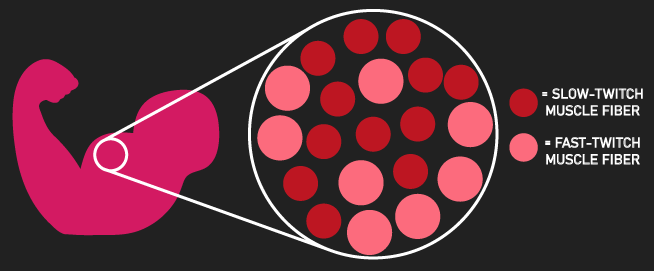
Given slow-twitch muscle fibers are highly resistant to fatigue and produce low amounts of power, it’s suggested higher rep ranges would grow these fibers more than lower rep ranges.
Conversely, given fast-twitch muscle fibers are less fatigue resistant but produce high amounts of power, lower rep ranges could grow these fibers more than higher rep ranges.
Therefore, alternating rep ranges for your exercises in your training program would ensure we maximize both slow-twitch and fast-twitch muscle fiber hypertrophy.
However, when repetitions are performed to or very close to failure (the point at which you can’t perform any more repetitions), the evidence does not support this.
A meta-analysis by Grgic et al. combined the results of 5 studies looking at this area.
In these 5 studies, the higher repetition groups trained with loads ranging from 30% to 50% of their one-rep max on an exercise, resulting in around 20-40 repetitions to failure each set.
The lower repetition groups trained with loads ranging 75% to 90% of their one-rep max on an exercise, resulting in around 3 to 10 repetitions to failure each set.
Combining the results of the 5 studies, growth of slow-twitch muscle fibers was similar between the higher repetition and lower repetitions groups.

Likewise, growth of fast-twitch muscle fibers was similar between the higher repetition and lower repetition groups.

Now, in this meta-analysis, the 95% confidence intervals were wide for both sets of results, essentially meaning we should approach the results with some caution, more research in the future will still be helpful.
Nevertheless, the idea that higher and lower reps do a similar job at growing slow-twitch and fast-twitch muscle fibers, provided those reps are performed to or very close to failure, would make a lot of sense.
Muscle fibers are recruited in a progressive sequence. During low effort tasks, slow-twitch muscle fibers are recruited. But, as your effort increases, faster-twitch muscle fibers are gradually recruited.

When using heavier loads and therefore lower repetitions, many slow-twitch and fast-twitch fibers are going to be initially recruited, as your effort is high straight away. As you near failure, more fast-twitch fibers are probably recruited to some degree as well.
When using lighter loads and therefore higher repetitions, the reps are going to be fairly low effort initially. But, as you continue and get closer and closer to failure, your effort increases. As a result, research indicates you ultimately end up with many slow-twitch and fast-twitch muscles recruited, probably similar to what you achieve with heavier loads.
So, the current evidence leans towards the idea that higher or lower reps do not stimulate different muscle fibers. This would suggest that mixing rep ranges would not be required for maximizing slow and fast-twitch muscle fiber hypertrophy.
Rep Ranges and Protein Activation
Interestingly, a different potential reason behind why you may want to use different rep ranges relates to the activation of proteins.
At the cellular level, muscle protein synthesis (the creation of the proteins that make our muscles bigger) can be traced back to the interaction of proteins in a chain-like reaction. The activation of the proteins that kick off the chain-like reaction is caused by lifting weights.

Due to differences in metabolic and mechanical stress between different rep ranges, they could activate different proteins. Therefore, alternating rep ranges could be beneficial.
Some research has indeed found that low and high reps result in the activation of different proteins. However, there is also research finding this not to be the case. So it’s not completely clear.
Nonetheless, let us now move on to the actual research exploring if using different rep ranges builds more muscle versus using only one rep range.
Alternating Rep Ranges: The Research
Schoenfeld et al.
Schoenfeld et al. split 19 men with an average of 4 and a half years of training experience into a constant or varied group.
Protocol:
Both groups trained three times per week, on non-consecutive days, for 8 weeks.
Each session, they trained the bench press, overhead press, lat pulldown, cable row, back squat, leg press, and knee extension for 3 sets each and 2 minutes of rest between sets
The constant rep group, for each exercise, used a load that allowed them to perform 8-12 reps to failure each set.
The varied group, on day 1 of each week, used a load allowing them to perform 2-4 reps to failure each set. On day 2 of each week, a load allowing them to perform 8-12 reps to failure each set. And on day 3 of each week, a load allowing them to perform 20-30 reps to failure each set.
Throughout the 8 weeks, both groups aimed progressively overloaded (so increase the load) within the rep ranges used.
Results:
Increases in elbow flexor, triceps brachii, and vastus lateralis thickness, measured by ultrasound, were statistically similar between both groups.
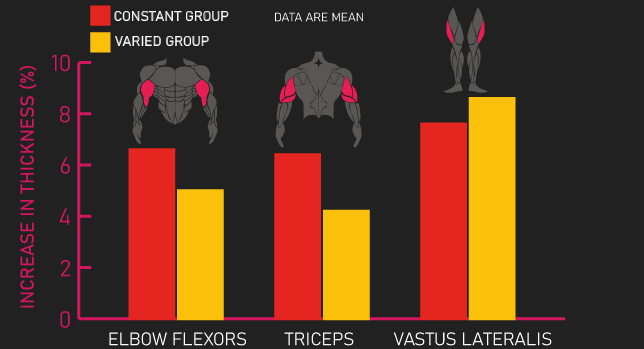
That said, increases in elbow flexor and triceps brachii thickness do appear to favor the varied rep group.
Discussion:
I managed to find an article by James Kreiger, one of the authors of this study, exploring this more.
Looking at the individual data for the triceps, there is one clear outlier in the varied group. After removing this outlier, the results still favor the varied group.
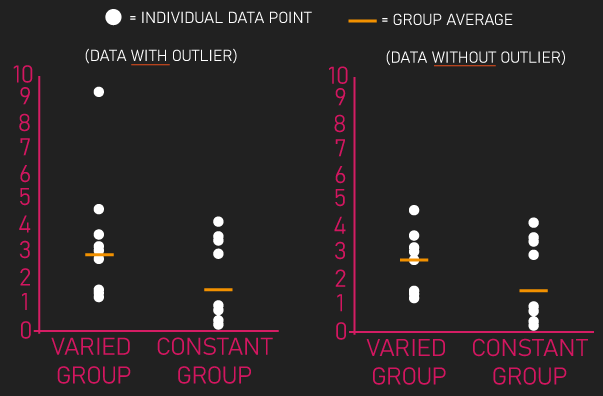
Looking at the individual data for the biceps, after removing one outlier from the constant rep group, the results are pretty similar.

Looking at the individual data for the vastus lateralis, the results are again similar.
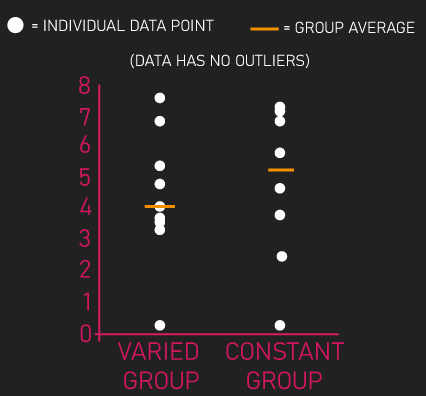
So, except for the triceps, the varied and constant rep group experienced similar gains. It seems likely that the triceps results were just due to random variation as it was not statistically significant. Remember, there were only 19 trained subjects in this study. Differences in genetics and degree of training experience could explain these findings.
As a result, this paper suggests mixing rep ranges does not improve muscle growth.
De Souza et al.
De Souza et al. split 26 untrained men into a constant, linear, or daily undulating group.
Protocol:
Both groups trained the smith machine squat and leg extension, twice per week for 6 weeks.
The constant group trained each exercise with 8 reps to failure.

The linear periodized group trained each exercise with 12 reps to failure for the first 4 weeks and then 8 reps to failure for the last 2 weeks.

The daily undulating group, for the first 4 weeks, used 12 reps to failure for each exercise on Monday, and 8 reps to failure on Thursday. For the last 2 weeks, they used 10 reps to failure for each exercise on Monday, and 6 reps to failure on Thursday.

Results:
Increases in quadriceps cross-sectional area, measured by MRI, was similar between all three groups.
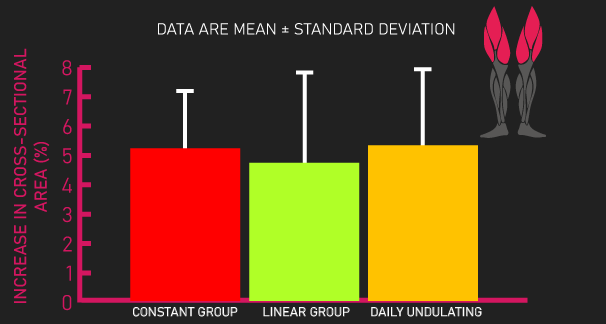
Therefore, this study further indicates alternating rep ranges is not more effective than using a constant rep range.
Before moving on, if you’re curious about creating an effective training program for muscle hypertrophy, our high quality partner Alpha Progression can help. It can generate a highly effective program for you, track your workouts live with in-built progression recommendations, provide graphs displaying your long term progress, and it has a massive exercise database with more than 550 exercises.
Click HERE (the link opens in a new tab) to get a free 2 week trial of the apps features. If you like it and go beyond, the link also gives you 20% off a subscription!
We never promote trash at the House of Hypertrophy, so rest assured the app is high quality. The reviews speak to this, 4.8 starts (based on more than 7,000 reviews) on Google play, and 4.9 stars in Apple’s store (based on nearly 400 ratings).
Fink et al.
Fink et al. assigned each arm of 21 untrained men into a high load, light load, or mix condition.
Protocol:
All subjects trained the unilateral dumbbell biceps curl, three times per week, on non-consecutive days, for 8 weeks.
The high load condition involved 3 sets to failure with an 80% one-rep max load every session and 2 minutes of rest between sets, resulting in around 7 to 3 reps per set.
The light load condition involved 3 set to failure with a 30% one-rep max load every session and 2 minutes of rest between sets, resulting in around 40 to 10 reps per set.
The mix condition, throughout the 8 weeks, alternated between 2 weeks of training with the high load condition and then 2 weeks of training with the light load condition.
Results:
Increases in elbow flexor cross-sectional area, measured by MRI, were similar between all three conditions.

Therefore, this study again suggests mixing rep ranges/loads does not improve muscle growth.
Other Research
There are a few other studies comparing the use of different rep ranges to using a constant rep range (Fishetti et al., Kraemer et al., Hunter et al., Baker et al., Helibronn et al., Monteiro et al., and Schiotz et al.).
However, the issue with these studies is they used body composition or circumference measurements.
These measurement tools are less sensitive and accurate compared to using MRI or ultrasound (Remember, the three studies we just looked at used MRI or ultrasound).
However, the majority of these studies still found no difference in body composition or circumference measurements between alternating rep ranges or using a constant rep range (Fishetti et al., Kraemer et al., Hunter et al., Baker et al., Helibronn et al., Monteiro et al., and Schiotz et al.). Adding further support to the idea mixing rep ranges does not improve muscle growth.
Mixing Rep Ranges in the Long Term?
Now, two studies (Fishetti et al. and Kraemer et al.) did observe improved body composition or circumference size when using different rep ranges. Interestingly, one of the studies by Kraemer et al. lasted 9 months in duration.
They split 27 untrained women into either a constant or varied rep group.
Both groups trained 3 times per week for 9 months.

The constant rep group performed 8 to 10 reps to failure for all exercises.
The varied group performed 4 to 6 reps to failure for each exericse on day 1 of each week, 8-10 reps to failure on day 2 of each week, and 12 to 15 reps to failure on day 3 of each week.
Increases in fat-free mass, measured by skinfold calipers, were significantly greater for the varied group.

Again, this measurement is not as sensitive or reliable compared to MRI or ultrasound measurements, so we should approach this with some caution.
But, if the varied group did truly experience greater muscle growth, I think there are two potential takeaways.
The subjects were women. All of the other studies assessed in this video were conducted on men. Perhaps alternating rep ranges improves muscle growth for women but not men. More research would needed to figure this out.
Secondly, this study lasted 9 months. All of the other studies assessed in this video lasted 12 weeks or less.
In the short term, there could be no difference between using different rep ranges or a constant rep range. But in the longer term, maybe using different rep ranges ultimately causes more muscle hypertrophy.
This is an interesting idea. Maybe using a constant rep range every session in the long term has some sort of desensitizing effect, meaning the use of different rep ranges could be superior for avoiding this problem. However, this is just a hypothesis.
Given we don’t have any other research lasting many months, it’s difficult to say. Hopefully, future research adds to this area.
Conclusion
To conclude, the current evidence leans towards the idea that both higher and lower reps produce similar slow and fast-twitch muscle fiber hypertrophy, indicating alternating rep ranges would not be advantageous in this aspect.
Moreover, the overall current research suggests that in the short term, mixing rep ranges does not improve muscle growth compared to using a constant rep range. It remains possible that in the long term, mixing rep ranges could improve muscle growth.
Practically speaking, no research has found alternating rep ranges to be inferior to using a constant rep range. So, alternating rep ranges is perfectly fine. For some, this could make training less monotonous and more enjoyable. And as discussed, maybe mixing rep ranges in the longer term is superior. But, future research is needed. If any more research comes out, I plan to make updated videos.
In some previous articles, we’ve gone into detail with rep ranges. We’ve evaluated if one-rep max training can be effective for building muscle, if reps between 2 and 4 can maximize hypertrophy, and what load may be too light to maximize hypertrophy. Be sure to check them out if you’re interested!
Remember to feel free to check out the Alpha Progression App if you’re interested. Also feel free to check out our free bench press e-book below.

